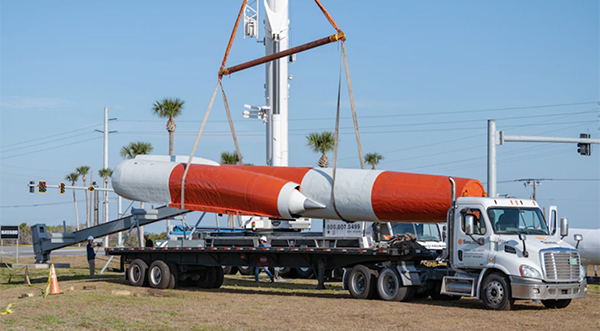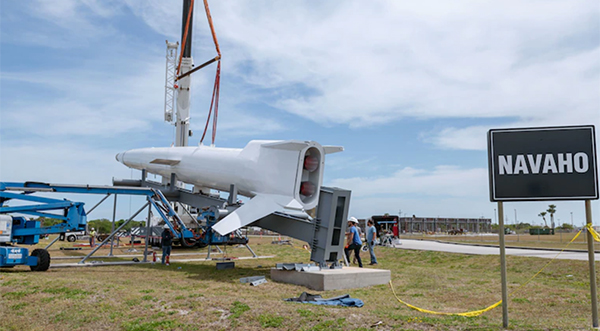Historic Navaho Missile Welcomes Visitors Once Again to Cape Canaveral Space Force Station
By Heather L. Scott, Chief of Media Operations, 45th Space Wing // March 31, 2021
Navaho was one of America’s earliest surface-to-surface missile prototypes

BREVARD COUNTY, FLORIDA – In October 2016, Hurricane Matthew skirted the shores of Eastern Florida as a category one storm, with wind gusts up to 100 mph. While a direct hit was avoided, intense winds caused damage to many facilities at both Patrick Space Force Base and CCSFS.
On a stand just outside the south gate of CCSFS stood a Navaho XSM-64 supersonic, winged intercontinental missile – the bright red and white landmark welcoming guests and station employees alike since 1999.
As a part of the Air Force Space and Missile Museum collection at CCSFS, the missile represented the strength of America’s pilotless bombers. Still, it was no match for Hurricane Matthew’s relentless offshore power.
By morning light after the storm passed, it was clear the Navaho was severely damaged, toppled off its launcher, and in need of extensive repairs.
The Navaho was one of America’s earliest surface-to-surface missile prototypes. The U.S. Air Force developed the Navaho to be a mobile launch vehicle set on a portable launch stand and supported by a movable service tower with the ability to go Mach 3 and reach an altitude of 77,000 feet. Eleven launches took place from Cape Canaveral starting in 1956 from test Launch Complex 9/10. The last Navaho launched from the Cape in November 1958.
Currently the AF Space and Missile Museum has one of the most complete collections of surface-to-surface missiles in the world on display. Museum Director James Draper believes the Navaho served as the source of what would become legacies in the U. S. space program.
“You can look at the Navaho program participants and see the heritage of the entire space program,” said Draper. “Navaho missile designers eventually went on to win Apollo and Shuttle program contracts and the company that designed the Navaho engine would go on to create the engines used for Redstone, Atlas, Titan and Saturn V missions to the Moon.”
For Draper, preserving the Navaho is not only about the missile’s background but about its future, as well.
“This particular article is the only intact Navaho known in existence, so it is extremely important to maintain and restore it so we can continue to educate visitors on its history,” Draper said.
The Navaho’s restoration was no small feat – the storm damage was compounded by years of corrosion from exposure to the harsh Florida salt air. Prime contractor Intergrated Construction Management, Inc. of Cape Canaveral oversaw the missile’s complete restoration. ICMI is a veteran-owned company that also served as prime contractor on the restoration of other items in Hangar C including the Hound Dog, the Polaris A3, and the Pershing II.
ICMI Program Manager Kevin Schrock believes the significance of the Navaho rests not only in its uniqueness, but in the way it can inspire generations to come.
“This missile is a part of the start of the space age, and seeing it in person gives a sneak peek into what international relations were like at the time and leading into the Cold War,” Schrock said. “It’s important to keep the heritage around so children can see what their predecessors came up with from scratch, through trial and error. And this is something they can come and see in real life, not in a textbook or photo online. It’s a truly striking piece to have back at the entrance to a U.S. Space Force installation.”
Much of the Navaho’s original structure was in need of repair, and even replacement of some components. This was the case with the missile’s booster.
“The nose cone is the only original component of the booster,” said Tom Meacham, project lead and Vice President of subcontractor Blast Off, Incorporated of Perdido, Alabama. “The missile itself was in better shape structurally. The manufacturer designed it with some give to accommodate for breaking the sound barrier, which helped it during the hurricane.”
Located near U.S. Army aviation center at Fort Rucker in Alabama, Blast Off, Inc. specializes in painting and restoration of historical aviation artifacts. The company recently delivered a restored Polaris A-3 missile to CCSFS in February 2021, and was the contractor that restored other items currently housed in Hangar C including the Agena B.
Draper is glad visitors can enjoy the Navaho and the Sands Space History Center now, and is excited about opening the remainder of the museum and Hangar C to guests.
“We’ve completed many upgrades, installed new exhibits, restored several artifacts and are excited to continue to share the rich history of America’s space and missile programs with the public,” said Draper.
To learn more about the Navaho or other pieces in the Air Force Space and Missile Museum visit www.afspacemuseum.org
CLICK HERE FOR BREVARD COUNTY NEWS













